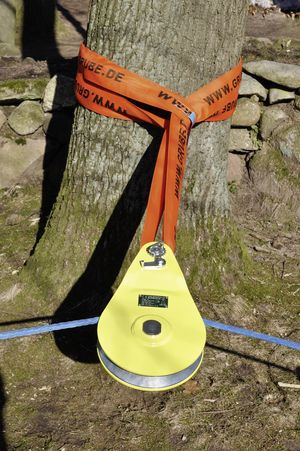KANBrief 1/18

Slinging equipment for logging applications, such as chains, ropes, pulleys or hooks, is used during cable skidding. It serves to connect the tree-trunk to the winch cable. It is important that slinging equipment selected for logging applications is suitable for the purpose and is sufficiently strong to withstand reliably the forces encountered. A standard dedicated to this subject has now been published.
The proper equipment for a logging winch is an important aspect for safe logging work. Tree-trunks are attached to a cable by means of slinging equipment (such as choker chains or ropes) in order to pull the trunks out of the cutting site. In the past, accidents occurred when the slinging equipment used for cable skidding failed. Such accidents resulted in persons being injured, in some cases seriously, by flying debris or the winch cable itself. Frequently, the accident was caused by the use of slinging equipment not adequately dimensioned for the power of the cable winch. Selection of suitable slinging equipment was made more difficult by the lack of harmonized labelling, and by requirements often being extrapolated from hoisting applications. The stresses arising during hoisting and cable skidding of tree-trunks are however completely different.
In 2011, the German Center for Forest Work and Technology (KWF) was commissioned by KAN to examine the existing safety standards governing forestry machines with regard to whether they satisfied the requirements of the European Machinery Directive. In the course of the study, it also became clear that no normative arrangements for slinging equipment used in cable skidding existed at that time in Germany or at European level. In response to an initiative by KAN, standards organizations began setting out requirements for testing and property specifications in this area.
Productive cooperation between experts in the OSH sector, manufacturers and the research community enabled the draft standard to be completed in the summer of 2017. The comments received in the course of the public enquiry were incorporated into the document at the end of last year.
DIN 30754, Forestry machinery – Requirements for slings used in ground traction mode, appeared in March 2018. It also applies to slinging equipment for rope-assisted tree felling. A key new feature is the term forest tractive force (FTF) followed by a decimal number, e.g. FTF 2.5 or FTF 6.0. The FTF value indicates the maximum permissible working load of the slinging equipment/maximum permissible tractive force generated by the logging cable winch during use of this slinging equipment. The required safety reserves for skidding are already allowed for in the FTF value. The user can therefore be confident that logging slinging equipment with an FTF value for example of 4.5 is suitable for use with a winch with a tractive force of 4.5 t and that the combination is safe. Selection of suitable components for logging work involving cable winches is thereby made substantially easier.
The pending steps are now trialling of the requirements in practice and presentation of the standard to the European standardization level. A number of European countries have already expressed interest in development of a European standard.
A further recommendation of the KAN study was the establishment of a permanent standards committee on forestry machinery at DIN, in order for the results of the study to be submitted effectively to standardization activity at national, European and international level. The Forestry Machinery standards committee was established in 2011 within the DIN Standards Committee Municipal Services (NKT). The standard governing logging slinging equipment was one of the first projects addressed by this committee. Growing interest in the subject of forestry technology resulted in the committee being extended at the end of 2017 to form the dedicated Technical Department Forestry technology. This technical department now includes the two working committees “Forestry machinery and associated equipment” and “Controls of forestry machinery”.
Katharina von Rymon Lipinski vonrymonlipinski@kan.de
Stefan Martin stefan.martin@grube.de